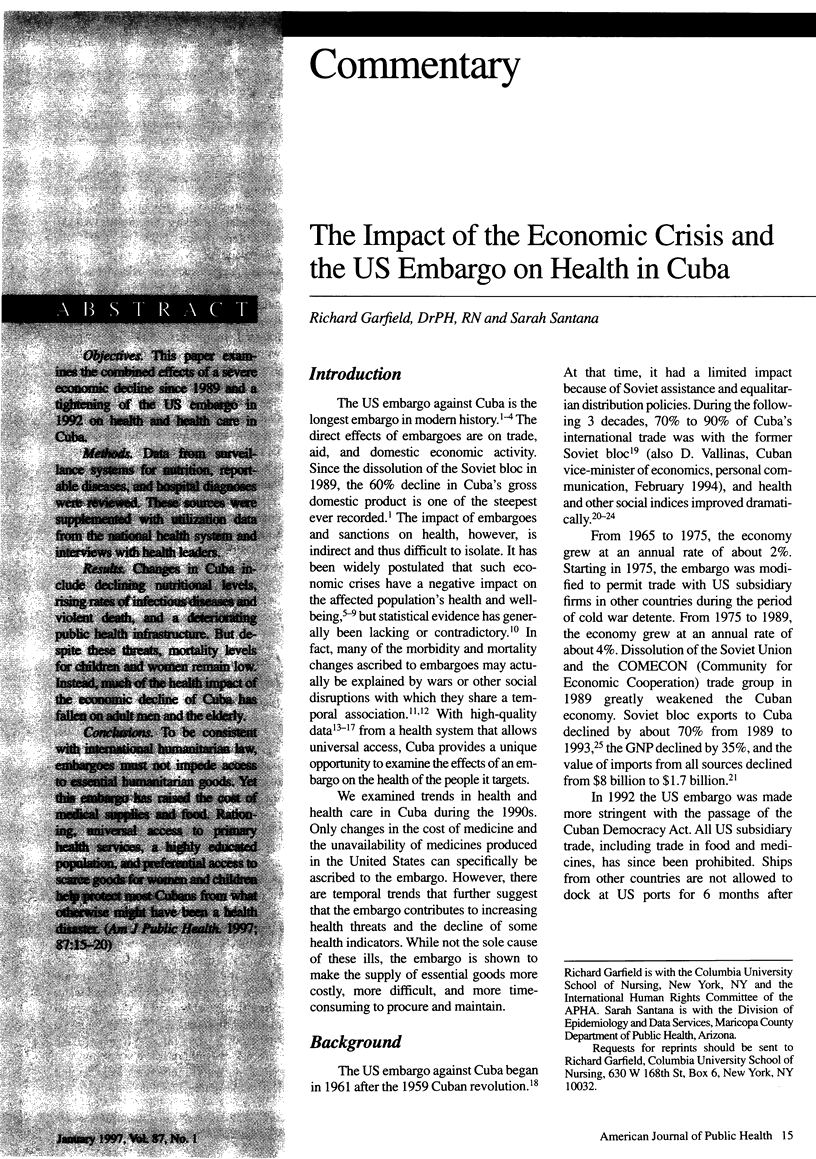Abstract
OBJECTIVES: This paper examines the combined effects of a severe economic decline since 1989 and a tightening of the US embargo in 1992 on health and health care in Cuba. METHODS: Data from surveillance systems for nutrition, reportable diseases, and hospital diagnoses were reviewed. These sources were supplemented with utilization data from the national health system and interviews with health leaders. RESULTS: Changes in Cuba include declining nutritional levels, rising rates of infectious diseases and violent death, and a deteriorating public health infrastructure. But despite these threats, mortality levels for children and women remain low. Instead, much of the health impact of the economic decline of Cuba has fallen on adult men and the elderly. CONCLUSIONS: To be consistent with international humanitarian law, embargoes must not impede access to essential humanitarian goods. Yet this embargo has raised the cost of medical supplies and food Rationing, universal access to primary health services, a highly educated population, and preferential access to scarce goods for women and children help protect most Cubans from what otherwise might have been a health disaster.
Full text
PDF





Selected References
These references are in PubMed. This may not be the complete list of references from this article.
- Garfield R. M., Frieden T., Vermund S. H. Health-related outcomes of war in Nicaragua. Am J Public Health. 1987 May;77(5):615–618. doi: 10.2105/ajph.77.5.615. [DOI] [PMC free article] [PubMed] [Google Scholar]
- Kirkpatrick A. F. Role of the USA in shortage of food and medicine in Cuba. Lancet. 1996 Nov 30;348(9040):1489–1491. doi: 10.1016/S0140-6736(96)07376-X. [DOI] [PubMed] [Google Scholar]
- Kuntz D. The politics of suffering: the impact of the U.S. embargo on the health of the Cuban people. Report of a fact-finding trip to Cuba, June 6-11, 1993. Int J Health Serv. 1994;24(1):161–179. doi: 10.2190/L6VN-57RR-AFLK-XW90. [DOI] [PubMed] [Google Scholar]
- Mas Lago P., Ramon Bravo J., Andrus J. K., Comellas M. M., Galindo M. A., de Quadros C. A., Bell E. Lessons from Cuba: mass campaign administration of trivalent oral poliovirus vaccine and seroprevalence of poliovirus neutralizing antibodies. Bull World Health Organ. 1994;72(2):221–225. [PMC free article] [PubMed] [Google Scholar]
- Murray C. J., Chen L. C. In search of a contemporary theory for understanding mortality change. Soc Sci Med. 1993 Jan;36(2):143–155. doi: 10.1016/0277-9536(93)90206-j. [DOI] [PubMed] [Google Scholar]
- Musgrove P. The economic crisis and its impact on health and health care in Latin America and the Caribbean. Int J Health Serv. 1987;17(3):411–441. doi: 10.2190/7EC9-PM6N-6LLJ-X2PC. [DOI] [PubMed] [Google Scholar]
- Sabin A. B. Perspectives on rapid elimination and ultimate global eradication of paralytic poliomyelitis caused by polioviruses. Eur J Epidemiol. 1991 Mar;7(2):95–120. doi: 10.1007/BF00237353. [DOI] [PubMed] [Google Scholar]
- Susser M. Health as a human right: an epidemiologist's perspective on the public health. Am J Public Health. 1993 Mar;83(3):418–426. doi: 10.2105/ajph.83.3.418. [DOI] [PMC free article] [PubMed] [Google Scholar]
- Terris M. The health status of Cuba: recommendations for epidemiologic investigation and public health policy. J Public Health Policy. 1989 Spring;10(1):78–87. [PubMed] [Google Scholar]
- Tucker K., Hedges T. R. Food shortages and an epidemic of optic and peripheral neuropathy in Cuba. Nutr Rev. 1993 Dec;51(12):349–357. doi: 10.1111/j.1753-4887.1993.tb03766.x. [DOI] [PubMed] [Google Scholar]
- Ubell R. N. High-tech medicine in the Caribbean. 25 years of Cuban health care. N Engl J Med. 1983 Dec 8;309(23):1468–1472. doi: 10.1056/NEJM198312083092334. [DOI] [PubMed] [Google Scholar]


